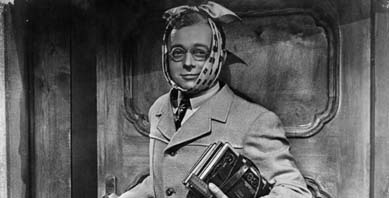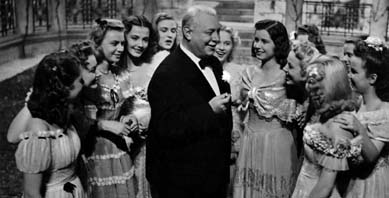Entertainment and Ideology in National-Socialist Film
"Politically Significant" Entertainment

In this light it is no wonder that comedies and light popular films played such a foregrounded role in the National-Socialist period. In 1939 alone —the year German troops invaded Poland and started the war — popular films made up 36% of the total production, followed by 34% in 1942, the year of the Third Reich's most intensive military expansion. The two 1933 propaganda movies "Hitlerjunge Quex" (Hitler Youth Quex) and "SA-Mann Brand" (Stormtrooper Brand) conveyed a National-Socialist world view to the masses: supposedly unpolitical Nazi comedies contain elements of propaganda as well, and even "politically significant" entertainment reflects the context in which it was made. This context is important to keep in mind especially since a majority of National-Socialist light entertainment films are still shown today on German television and in cinemas and are distributed on video and dvd as well, unlike the propaganda films and entertainment films with propagandistic content, which can be viewed only "conditionally".
Two comedies that remain popular today provide good examples of the combination of ideology and entertainment. One is the Tobis-Film production "Altes Herz wird wieder jung" (An Old Heart Becomes Young, 1942/43), the last film featuring the great screen star Emil Jannings, which continues to be presented as a family-oriented "light comedy." The other is the Heinz Rühmann classic "Die Feuerzangenbowle" (The Fire Tongue Bowl, 1943), which is venerated to this day as a cult film and is regularly shown to high school students, with whom it is especially popular.
"Die Feuerzangenbowle" ("The Fire Tongue Bowl")

In the case of "Die Feuerzangenbowle", in which Heinz Rühmann plays the rogue Pfeiffer, a made man who returns to the school bench, the film's National-Socialist ideological context is barely noticeable, at least on the surface. But upon closer inspection, certain features of the film stand out, particularly the character of Brett the schoolteacher and the function he performs in this highly popular comedy. Brett's maxim, which is affirmed repeatedly throughout the film, goes as follows: "Growing saplings must be bound so that they grow not crooked but straight; and so, too, is it with young people. Discipline is the rope that binds them — forcing a beautiful, straight growth!" The dapper, young, and well-liked teacher appears as a representative of what the National-Socialists termed "the new era"; his pedagogical maxim is reminiscent of the image of the German forest, instrumentalized, as in the propaganda film "Ewiger Wald" (The Enchanted Forest, 1936), as the symbol of the army and the Volk. The ideal of a "beautiful, straight growth" could also be understood in terms of the Nazis' hysterical racism, according to which so-called Aryans were promoted as a superior race, and millions of men, women, and children were categorized as "subhuman" or "ethnically pernicious" and murdered outright.
"Altes Herz wird wieder jung": From Family Comedy…

Even the comedy "Altes Herz wird wieder jung" (An Old Heart Becomes Young), upon closer inspection, manifests numerous allusions to National-Socialist ideology and politics. The film, directed by Erich Engel and featuring a star-studded cast (including Emil Jannings, Paul Hubschmid, Viktor de Kowa, and Elisabeth Flickenschildt), was "anything but a strident propaganda film," as film historian and journalist Gerald Koll has argued: "Its method of indoctrination was much more elegant."
At first glance, the film simply tells the story of a young girl, Brigitte (Maria Landrock), who in 1938, while looking for a job, ends up discovering her lost grandfather; soon, she finds herself with not only a new family and a job as a secretary, but with a husband as well. The gruff, old factory-owner Hoffmann, who had always believed he was childless, finds a new lease on life with the surprise appearance of his granddaughter. His relatives, expecting the inheritance, must learn to get used to the at-first unknown young woman at Hoffmann's side. His clever nephew (Viktor de Kowa), who hires Brigitte, ends up falling in love with the young woman and at the end of the film the two are making wedding plans.
This apparently unpolitical story about a family reunited was nevertheless quite "current", as the magazine "Film-Kurier" had already noted in flattering review in April 1943. From the very start the film is fraught with features of the National-Socialists' racist doctrine and policies. As Brigitte confesses, the decision to search for her lost grandfather was motivated by "descent worries", a reference to the so-called "Aryan Certificate" that from March 1933 on had been a requirement for all workers, civil servants, lawyers and judges, doctors, and university students. In keeping with the Nazis' racist policies, the families of such persons had to be "pure Aryan" as far back as the grandparents.
…To the National-Socialist Genetic Doctrine

"Altes Herz wird wieder jung" thus not only lends justification to the "Aryan Certificate" requirement — it is, after all, the reason for the family's reunification and common happiness — but confirms some basic ideological themes of the Nazis. Alongside numerous references to Hitler's visit to Mussolini and the expansion of a "Greater German Reich", the question of descent is of central importance. One of the foundations of the Nazis" racist world view and policy of annihilation was their instrumentalization of the genetic doctrine: Not only physical features, but character and "nature" were considered to be inherited. From this the Nazis developed their construct of the "Jewish race" and their dictate to preserve the purity of the "Aryan race". The application of the genetic doctrine in the societal context led to mandatory sterilizations and mass murder. It is this belief in the "preservation of purity" and in the inheritance of personal character and values that subtly underpins "Altes Herz wird wieder jung". Hoffmann's granddaughter Brigitte unambiguously shows herself to be his direct descendant through a kind of natural affinity: They share not only a similar taste in music but speech patterns as well. In order to preserve this "purity" it appears only logical that Hoffmann's granddaughter should take Hoffmann's nephew for a husband. The two ends of the circle of the national "We" are thus to be joined in the "new era" of Nazi Germany. This quintessence is so important for the film that Hoffmann emphasizes it once more in a final monologue: "A new era is coming over our country. Man not only looks ahead with new courage, but — heedfully — back to his ancestors, as well."